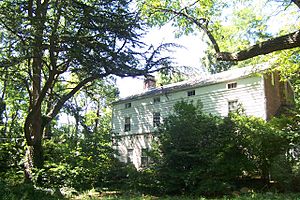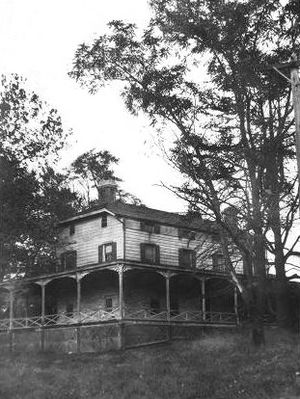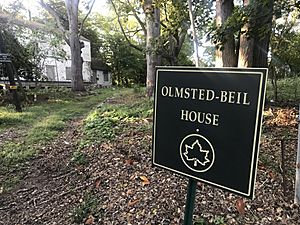Olmsted–Beil House facts for kids
The Olmsted-Beil House is a historic farmhouse located on Staten Island, New York City. It sits on a hill with great views of Raritan Bay and Sandy Hook in New Jersey. In 1848, the father of Frederick Law Olmsted bought this property. He gave it to Frederick, who used it as a farm. Frederick Law Olmsted is famous for designing Central Park in New York City. He grew crops, planted trees, and raised animals here.
Contents
History of the Olmsted-Beil House
The very first owner of this land was Dominic Petrus Teaschenmaker. He received official permission for the property from Governor Thomas Dongan in 1685. Later, around 1696, a man named Jacques Poillon acquired the property. He was a road commissioner and one of the first Huguenot settlers on Staten Island. Poillon made the stone basement of the house bigger, turning it into a Flemish-style farmhouse.
Early Owners and the Revolutionary War
By 1723, three generations of the Poillon family had lived in this house. During the American Revolutionary War, John Poillon was part of the Committee of Safety for Richmond County. This group worked to protect the people during the war. John Poillon helped arrange a famous meeting called the Peace Conference. This meeting happened at Bentley Manor, now known as the Conference House.
Later, Dr. Samuel Akerly bought the farmhouse. He was one of the people who started the New York Institute for the Blind. Dr. Akerly made the farmhouse much larger, adding up to thirteen rooms. He also wrote many articles about farming on Staten Island. He helped change how people farmed by improving equipment and crop rotation.
Frederick Law Olmsted's Farm
Frederick Law Olmsted renamed the farmhouse "Tosomock." This name honored the first owner, Teaschenmaker. Olmsted made many improvements to the house. He added a 1+1⁄2-story section to the top, with small windows under the roof. He also added porches on three sides of the farmhouse. These porches are no longer there today.
Olmsted used the property as a tree nursery. He planted many unusual types of trees on his farm. You can see a huge Cedar of Lebanon tree in one of the old photos. There are also some Osage Orange trees near the property. The farm originally stretched across Hylan Boulevard all the way to the beach. After Olmsted sold the farm, people started calling the area the Woods of Arden.
Landmark Status and Restoration
The Olmsted-Beil House was named a New York City designated landmark in 1967. This means it is an important historical building. However, the house has fallen into disrepair over the years. Renovations and repairs are needed to fix it up. The New York City Department of Parks and Recreation is working to restore the farmhouse. They want to make it look like it did when Olmsted lived there. The house was also added to the National Register of Historic Places in 2020.
Images for kids






